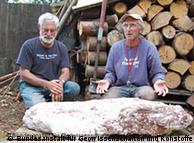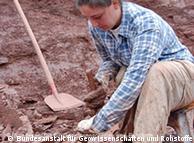Paleontologists uncover 300 million-year-old reptile skeleton in central Germany
Scientists have discovered the well-preserved fossil of a primitive
reptile at the Bromacker Quarry in the heart of Germany's Thuringian
Forest. The find dates back to the Permian period, well before the
dinosaurs.
An old sandstone quarry in central Germany has yielded another
significant paleontological find: the skeleton of a 60-centimeter
primitive reptile some 300 million years old.
The fossil was unearthed on August 4 at the Bromacker Quarry near the
town of Tambach-Dietharz, where scientists have been organizing annual
digs since 1993.
Thomas Martens, a paleontologist from the Nature Museum in Gotha,
Germany, and a member of the excavation team, said the group found what
they hope is a complete skeleton.
"When we find these things, we don't know if it's the whole or
partial skeleton," he told Deutsche Welle. "But we saw parts of limbs
and vertebrae in an articulation – meaning the bones are still
together."
Scientists have yet to determine whether their newest find constitutes a new species of primitive reptile.
The 2010 excavation brought together scientists from Europe and the
United States, including paleontologists from the Carnegie Museum of
Natural History in Pittsburgh (USA), California State University San
Bernardino (USA), and Comenius University in Bratislava, Slovakia.
 Bildunterschrift: Großansicht des Bildes mit der Bildunterschrift: The primitive reptile fossil is estimated to be approximately 300 million-years-old.From field to fossil prep Bildunterschrift: Großansicht des Bildes mit der Bildunterschrift: The primitive reptile fossil is estimated to be approximately 300 million-years-old.From field to fossil prep
The team is still waiting to transport the skeleton overseas to
Pittsburgh in order to extract the fossil. Until then, scientists will
have to wait to categorize their latest find.
"We really won't know until we prepare the fossil," said Amy Henrici,
collection manager at the Carnegie Museum of Natural History in
Pennsylvania and one of the paleontologists responsible for the
preparation work.
Based on what the team saw in the field, Henrici told Deutsche Welle
that the specimen is thought to be from the order pelycosaur. "This is
the group of animals that eventually gave rise to mammals," she said.
Though discoveries of that order are rare at the Bromacker site, the
new animal is thought to look something like the pelycosaur dimetrodon, a
predatory reptile featuring a sail-like back.
"It's a big, stocky, sort of Komodo dragon-like animal," Henrici
said. The team hopes the new skeleton includes a skull – something
missing from two pelycosaur specimens unearthed during previous digs.
Since work started at the Bromacker Quarry 18 years ago, researchers
have discovered a range of well-preserved fossils at the location.
"We're finding complete animals with all their toes and wrists and ankle
bones - which is very unusual," she said.
Specimens found at the site in central Germany date back to the early Permian period, more than 250 million years ago.
 Bildunterschrift: Großansicht des Bildes mit der Bildunterschrift: Amy Henrici says scientists suspect the fossil is from the order pelycosaur, the group that later gave rise to mammals.The Pangaea connection Bildunterschrift: Großansicht des Bildes mit der Bildunterschrift: Amy Henrici says scientists suspect the fossil is from the order pelycosaur, the group that later gave rise to mammals.The Pangaea connection
The Bromacker discoveries have also shed new light on the origin of
the continents, and the existence of the single super-continent Pangaea
some 300 million year ago. Paleontologists have discovered similar
fossils in both Bromacker Quarry and the southwestern United States,
such as the tetrapod species Seymouria sanjuanensis.
Henrici noted the first evidence for Pangaea's existence was based on
rock types and plant fossils, but the Permian reptiles found in Germany
add a new dimension: "The Bromacker provides the first good vertebrate
evidence," she said.
Despite the super-continent connection, the excavations in central
Germany have yielded species some 10 million years older than those
unearthed in North America. Moreover, the specimens uncovered so far do
not constitute the oldest terrestrial reptiles on earth, though Martens
described them as "near the root of this family tree."
Scientists' latest find is, however, unrelated to the dinosaurs - the
species found at the Bromacker Quarry predates its Mesozoic era
counterparts by tens of millions of years.
Author: Amanda Price
Editor: Cyrus Farivar
http://www.dw-world.de/dw/article/0,,5916596,00.html
| 








